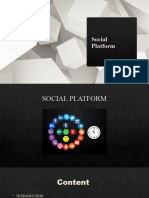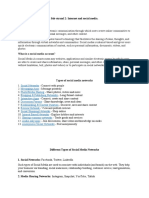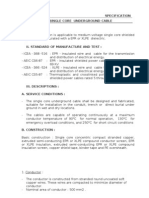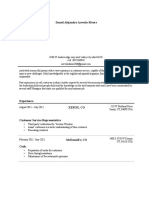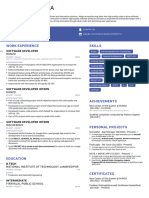Module 3 Notes
Uploaded by
Chaya AnuModule 3 Notes
Uploaded by
Chaya AnuMODULE-III: SOCIAL MEDIA OVERVIEW AND SECURITY
Introduction to Social Networks
✓ Social networks have become an integral part of our daily lives. These online platforms enable
individuals to connect, communicate, and share information with a global audience.
Understanding the fundamentals of social networks is crucial in today's interconnected world.
What are Social Networks?
✓ Social networks, often referred to as social media, are online platforms that facilitate the
creation and exchange of information, ideas, and content among users. They serve as virtual
communities where individuals, organizations, and even celebrities can interact with one
another.
Popular Social Networks
Several social networks have gained immense popularity over the years:
1. Facebook: One of the pioneers of social media, Facebook allows users to connect with friends
and family, share text and multimedia content, and join interest-based groups.
2. Twitter: Known for its micro blogging format, Twitter enables users to share short messages or
"tweets" with a vast audience.
3. Instagram: Focused on visual content, Instagram is a platform for sharing photos and short
videos.
4. LinkedIn: Tailored for professional networking, LinkedIn connects individuals in the business
world, facilitating job searches and industry-related discussions.
Key Features of Social Networks
✓ Profiles: Users create profiles with personal information and content they wish to share.
✓ Connections: Users connect with others by sending or accepting friend or follow requests.
✓ Feeds: A central feature where users see content from people and organizations they follow.
✓ Sharing: Users can post text, images, videos, and links for others to see and interact with.
✓ Privacy Settings: Users can control who sees their content and information.
Examples in Action
1) A student uses Facebook to stay connected with friends, share vacation photos, and
participate in discussions about their favourite TV shows.
2) Business professional leverages LinkedIn to expand their network, stay informed about
industry trends, and search for job opportunities.
Why is it Important?
1) Connecting People: Social networks break down geographical barriers, allowing individuals to
maintain relationships across the globe.
2) Information Sharing: They serve as platforms for sharing news, knowledge, and experiences.
3) Business and Marketing: Companies use social networks for advertising, customer
engagement, and market research.
Challenges and Considerations
1) Privacy Concerns: Users must be aware of the privacy settings and potential data collection
by social media companies.
2) Cyber bullying: The anonymity of the internet can lead to cyber bullying, which is a growing
concern on social networks. Understanding the basics of social networks is the first step in
harnessing their potential for personal and professional use. Whether connecting with
friends, engaging in business opportunities, or staying informed about the world, social
networks have become an integral part of modern communication.
Types of social media
✓ Social media is a diverse landscape that offers various platforms, each designed for specific
purposes. Understanding the different types of social media is essential for both personal and
professional engagement in the digital age.
1) Social Networking Sites: Social networking sites are perhaps the most common type of social media.
They focus on connecting individuals and fostering relationships. Examples include Facebook, Twitter,
and Instagram.
2) Facebook: This platform enables users to create profiles, connect with friends, and share personal
updates, photos, and videos.
3) Twitter: Twitter is known for its microblogging format, where users post short messages or "tweets"
to share thoughts, news, and updates.
4) Micro blogging Platforms: Micro blogging platforms, like Twitter, emphasize short and concise posts.
They are ideal for quickly sharing information and engaging in real-time discussions.
5) Content Sharing Sites: Content sharing sites centre around visual or multimedia content. Instagram,
Pinterest, and Snap chat are popular examples.
6) Instagram: Instagram is dedicated to sharing photos and short videos, making it a hub for visual
storytelling.
7) Pinterest: Pinterest is a virtual pin board where users collect and share ideas, images, and content
related to their interests.
8) Professional Networking Sites:
9) LinkedIn stands out as the primary platform for professional networking. It connects individuals based
on their careers and allows for job searches, industry discussions, and professional networking.
10) Video Sharing Platforms: YouTube is the leading platform for sharing and discovering videos. Users
upload a wide range of content, from educational tutorials to entertainment.
11) Blogging Platforms:
12) platforms, such as Word Press and Blogger, enable users to create and manage their blogs. Bloggers
can publish articles, stories, and content on specific topics of interest.
Discussion Forums:
Discussion forums like Reddit and Quora facilitate in-depth discussions on a wide array of subjects.
Users can ask questions, provide answers, and engage in conversations with others.
1) Messaging Apps: Messaging apps, like WhatsApp, Facebook Messenger, and WeChat, are
designed for private or group communication. They often include features like voice and video
calls.
2) Live Streaming Platforms: Live streaming platforms like Twitch and Periscope enable users to
broadcast live video content. These platforms are particularly popular among gamers and content
creators.
3) Niche or Specialized Platforms: Numerous niche social media platforms cater to specific interests
or communities. Examples include Strava for athletes, good reads for book lovers, and Deviant Art
for artists. Understanding the variety of social media types empowers users to choose the
platforms that align with their goals, whether for personal networking, professional development,
or content creation. It's crucial to explore and utilize these platforms effectively for a well-rounded
online presence.
Social Media Platforms
Social media platforms are online spaces where users can build profiles, connect with
others, and share content. These platforms offer a wide range of features tailored to
specific purposes and user preferences.
Key Features of Social Media Platforms
1. User Profiles: Users create profiles, which often include personal information, profile
pictures, and cover photos.
2. Connections: Users establish connections with others through methods like sending
friend requests or following accounts.
3. Content Sharing: Platforms allow users to share a variety of content, including text
posts, images, videos, links, and more.
4. Feeds: Most platforms feature a feed or timeline, where users see content from accounts
they follow.
5. Notifications: Users receive notifications about interactions with their content, like
comments, likes, or shares.
Examples of Social Media Platforms
1. Facebook: A versatile platform that combines various types of content sharing,
including text updates, photos, videos, and links. Users can connect with friends and
join interest-based groups.
2. Twitter: Known for its brief and real-time updates, Twitter is popular among those who
want to stay informed about current events, share thoughts, and engage in discussions.
3. Instagram: Focused on visual content, Instagram is ideal for sharing photos and short
videos. It emphasizes visual storytelling and creative expression.
4. LinkedIn: Professional networking platforms where individuals create profiles
highlighting their careers, connect with colleagues, and explore job opportunities.
5. YouTube: The world's leading video-sharing platform, where users upload, watch, and
engage with videos on a vast range of topics.
6. Pinterest: A platform centred on collecting and sharing visual inspiration and ideas.
Users "pin" content to virtual boards.
7. Reddit: A discussion forum platform where users participate in conversations about
numerous topics by creating posts and responding to others.
The Role of Social Media Platforms
1. Personal Connection: Platforms like Facebook help users connect with friends and
family, regardless of geographical distances.
2. Content Sharing and Discovery: Social media platforms enable content creators to
share their work with a global audience and allow users to discover new content.
3. Business and Brand Promotion: Companies use platforms like Instagram and Twitter
for marketing, customer engagement, and brand building.
Social Media Monitoring
✓ What is Social Media Monitoring?
Social media monitoring is the practice of observing, collecting, and analysing data from
social media platforms to gain insights into audience sentiment, trends, and conversations.
It's a proactive way of staying informed and responding effectively to online activity related
to a brand or topic.
Key Components of Social Media Monitoring:
1. Data Collection: Social media monitoring tools gather data from platforms like
Facebook, Twitter, Instagram, and others. This data includes mentions, comments,
shares, and more.
2. Sentiment Analysis: Sentiment analysis tools determine whether mentions are positive,
negative, or neutral. This helps assess public perception.
3. Trend Analysis: Monitoring platforms can identify emerging trends and popular topics
in real-time.
4. Competitor Analysis: Brands can analyse the social media activity of their competitors
to benchmark their own performance.
Why is Social Media Monitoring Important?
1. Customer Insights: It offers valuable insights into customer opinions and preferences,
helping businesses tailor their products and services accordingly.
2. Crisis Management: Rapid response to negative comments or potential crises is crucial
for reputation management.
3. Market Research: Monitoring provides real-time market data, allowing businesses to
make informed decisions.
4. Competitive Advantage: Understanding competitor strategies and customer responses
can give businesses a competitive edge.
Examples of Social Media Monitoring
1. Customer Service: Brands use social media monitoring to address customer complaints,
questions, and feedback promptly. For example, airlines use Twitter to assist passengers
during travel disruptions.
2. Trend Identification: Trending hash tags and topics on platforms like Twitter often
reflect real-time public sentiment and concerns.
3. Brand Reputation: Companies keep a close eye on mentions of their brand to ensure
they are perceived positively.
Tools for Social Media Monitoring:
✓ Several tools and software are available for social media monitoring, including Hootsuite,
Mention, Google Alerts, and social media analytics within individual platforms.
Best Practices for Social Media Monitoring:
1. Establish clear objectives for monitoring.
2. Determine relevant keywords, hash tags, and accounts to track.
3. Set up alerts and notifications for timely responses.
4. Regularly analyse and interpret the collected data.
Hash tags
Hash tags are a fundamental element of social media, serving as a way to categorize
content, increase its visibility, and join online conversations. Understanding how to use
hash tags effectively are crucial for both personal and professional engagement on social
platforms.
Definition of Hash tags
A hash tag is a word or phrase preceded by the "#" symbol. It turns the word or phrase into a
clickable link, leading to a feed of posts that share the same tag. For example, #ThrowbackThursday
is a popular hash tag used for sharing nostalgic content on social
media.
The Role of Hash tags
1. Categorization: Hash tags help organize content by subject or theme. This makes it easier for
users to find and engage with posts relevant to their interests.
2. Search and Discovery: Users can search for specific hash tags to discover content related to
topics they care about.
3. Trending Topics: Hash tags can go viral and become trending topics, drawing widespread
attention to a particular subject or event.
How to Use Hash tags
1. Choose Relevant Hash tags: Select hash tags that are directly related to the content you are
sharing. For example, if posting about a travel adventure, you can use #TravelTuesday or
#Wanderlust.
2. Don't Overdo It: Avoid using too many hash tags in a single post. Two to five relevant hash tags
are usually sufficient.
3. Research Trending Hash tags: Utilize trending hash tags when relevant to your content to
increase its visibility.
4. Create Branded Hash tags: Businesses often create unique, branded hash tags to promote
products or campaigns. For example: #ShareACoke.
Examples in Action
1. A travel enthusiast posts a picture of a beautiful beach with the hash tags #ParadiseFound and
#Wanderlust to share their experience and attract like-minded travellers.
2. During a global event like the Olympics, users across the world use the hash tag #Olympics to
join the conversation and stay updated on the latest developments.
Benefits of Using Hash tags
1. Increased Visibility: Posts with relevant hash tags are more likely to be discovered by a wider
audience.
2. Community Engagement: Hash tags help connect with communities of people interested in the
same topics.
3. Tracking Campaigns: For businesses, branded hash tags help track and measure the success of
marketing campaigns.
Viral Content
✓ What is Viral Content?
Viral content refers to online content that becomes extremely popular and spreads quickly.
It's shared and discussed by a significant number of people, often achieving a level of fame
and recognition
Key Elements of Viral Content
1. Emotionally Resonant: Viral content often evokes strong emotions, whether it's laughter, awe,
anger, or empathy. Emotional content is more likely to be shared.
2. Reliability: Content that is relatable to a broad audience has a higher chance of going viral.
People like to share what they can connect with.
3. Surprise and Novelty: Viral content often surprises viewers or presents a fresh perspective on a
common topic.
4. Simplicity: Simple and easy-to-understand content tends to be shared more. Complex ideas are
less likely to go viral.
5. Timeliness: Content that relates to current events, trends, or timely topics is more likely to go
viral. It's important to be in the right place at the right time.
Examples of Viral Content
✓ Memes: Memes are humorous or relatable images or videos often paired with witty captions.
They can spread like wildfire due to their humour and reliability.
✓ Viral Challenges: Internet challenges like the Ice Bucket Challenge gained widespread attention
and participation due to their social impact.
How to Create Viral Content?
1. Understand Your Audience: Know your target audience's preferences, interests, and
emotional triggers.
2. Be Creative: Create unique and engaging content that stands out from the crowd.
3. Leverage Trends: Stay informed about the latest trends and current events to create
content that's timely and relevant.
4. Promotion: Sharing content on multiple platforms and using relevant hash tags can
increase its reach.
Benefits and Implications
1. Brand Exposure: Businesses can benefit from viral content to gain exposure and
increase brand awareness.
2. Individual Recognition: Content creators can achieve recognition and build a following
by producing viral content.
Social Media Marketing
✓ What is Social Media Marketing?
Social media marketing is the use of social media platforms to promote products, services,
or brands. It involves creating and sharing content on social networks with the aim of
achieving marketing and branding goals.
Key Components of Social Media Marketing
1. Content Creation: Developing high-quality and relevant content for social media, including
posts, images, videos, and articles.
2. Audience Engagement: Interacting with your audience, responding to comments, and fostering
a sense of community.
3. Advertising: Paid social media advertising can help target specific audiences and
increase reach.
4. Analytics: Monitoring the performance of social media campaigns and adjusting
strategies based on data and insights.
Benefits of Social Media Marketing
1. Increased Brand Awareness: Social media platforms offer a broad audience reach,
making it ideal for brand exposure.
2. Targeted Advertising: Social media advertising allows precise targeting based on
demographics, interests, and behaviours.
3. Engagement and Community Building: social media fosters two-way communication
and engagement with customers, building brand loyalty.
4. Cost-Effective: Compared to traditional advertising, social media marketing can be more
cost-effective, especially for small businesses.
Examples of Social Media Marketing
✓ A clothing brand running a Facebook ad campaign targeting users interested in fashion and
clothing.
✓ A restaurant using Instagram to showcase its dishes, connect with food enthusiasts, and
promote special offers.
Best Practices for Social Media Marketing
1. Know Your Audience: Understand your target audience's demographics, interests, and
behaviours to tailor content and ads.
2. Content Calendar: Plan and schedule content to maintain a consistent and relevant online
presence.
3. Engagement and Interaction: Actively respond to comments, messages, and mentions, fostering
engagement and loyalty.
4. Use of Hash tags: Incorporate relevant hash tags to increase content discoverability.Social Media
Privacy
What is Social Media Privacy?
Social media privacy refers to the control individuals have over their personal information
and the content they share on social networking sites. It encompasses settings, practices,
and choices that determine who can access your data and interactions.
Key Aspects of Social Media Privacy
1. Profile Privacy: Users can adjust settings to control who can see their profile, posts, and personal
information. This includes options for public, friends only, or custom settings.
2. Data Sharing: Social media platforms may collect and share user data for targeted advertising.
Understanding and managing these settings is important.
3. Third-Party Apps: Be cautious when granting access to third-party applications; they may have
access to your data.
4. Location Services: Some social media platforms collect and share your location data. It's
essential to control this feature.
5. Authentication: Use strong, unique passwords, and enable two-factor authentication to secure
your account.
The Importance of Social Media Privacy
1. Protect Personal Information: Privacy settings safeguard sensitive information from being
visible to the entire internet.
2. Minimize Risks: Sharing personal information can lead to identity theft, stalking, and
harassment.
3. Maintain Reputation: Responsible privacy practices help maintain a positive online reputation.
Examples of Social Media Privacy Practices
Adjusting Facebook privacy settings to limit the visibility of posts to friends only. Reviewing and
revoking access to third-party apps on Twitter that have access to your
account.
Challenges and Considerations
✓ Data Collection: Social media platforms collect user data, sometimes for advertising purposes.
Understand these policies and manage your settings accordingly.
✓ Scams and Phishing: Be cautious of suspicious messages or requests, as they might be scams
or phishing attempts.
Best Practices for Social Media Privacy:
1. Regularly Review Privacy Settings: Periodically check and adjust your privacy settings on social
media platforms.
2. Limit Personal Information: Only share necessary personal information, and avoid sharing
sensitive data.
3. Secure Your Account: Use strong, unique passwords and enable two-factor authentication
where available.
4. Be Cautious with Accepting Requests: Only accept friend or connection requests from
individuals you know.
5. Educate Yourself: Stay informed about privacy policies and practices on different platforms.
Protecting your privacy on social media is an ongoing effort that involves staying informed,
using platform tools effectively, and making informed choices about what and with whom
you share. Balancing engagement with security ensures a safer and more enjoyable online
experience.
Challenges and Opportunities in Online Social Networks
Online social networks have reshaped the way we connect and share information, offering
both tremendous opportunities and complex challenges. Understanding these dynamics is
crucial for effective and responsible engagement in the digital age.
Challenges in Online Social Networks
1. Cyber bullying: Online platforms provide anonymity, making it easier for individuals to engage
in cyber bullying, causing emotional distress and harm.
2. Privacy Concerns: The collection and sharing of personal data on social media platforms have
raised concerns about user privacy and data security.
3. Addiction and Mental Health: Excessive use of social media can lead to addiction and have
negative effects on mental health, including anxiety and depression.
4. Disinformation and Fake News: The rapid spread of false or misleading information on social
media can harm public opinion and decision-making.
5. Online Harassment: Users, particularly women and minority groups, often face harassment,
hate speech, and threats on social networks.
Opportunities in Online Social Networks
1. Networking and Connections: Online social networks facilitate global connections and
enable users to engage with individuals sharing similar interests and goals.
2. Information Sharing: Users can access and share information, news, and knowledge on a vast
scale, leading to greater awareness.
3. Business Promotion: Social networks are valuable tools for businesses to market products and
engage with customers, potentially leading to growth and success.
4. Social Activism: Online platforms have become powerful tools for social and political activism,
enabling the mobilization of large groups for change.
5. Creativity and Expression: social media provides a platform for individuals to express their
creativity, from art to writing, and gain recognition.
Strategies to Navigate Challenges:
1. Digital Literacy: Education and awareness about online risks and responsible digital citizenship
is vital.
2. Privacy Settings: Regularly review and adjust privacy settings to protect personal information.
3. Mindful Engagement: Balance your online activity with offline life, and take breaks to avoid
addiction.
4. Reporting and Moderation: Use platform tools to report abusive or inappropriate content and
encourage responsible community standards.
5. Media Literacy: Develop critical thinking skills to discern reliable information from
misinformation.
✓ Online social networks are powerful tools for communication, networking, and information
sharing. However, users should be aware of the challenges and employ strategies to navigate
the digital landscape safely and responsibly, fostering a positive online environment.
Security Issues Related to social media
While social media platforms offer valuable opportunities for networking and communication,
they also pose security risks. Understanding these security issues and how to protect yourself is
crucial for responsible and safe engagement in the digital world.
Common Security Issues on social media
1. Hacking: Malicious individuals or groups may attempt to gain unauthorized access to your social
media accounts, leading to identity theft or misuse.
2. Phishing: Cybercriminals use deceptive emails or messages to trick users into revealing personal
information, such as passwords and financial details.
3. Malware Distribution: Links or attachments in social media messages can lead to the download
of malware onto your device.
4. Fake Accounts: Fake or impersonated profiles may be used for scams, harassment, or spreading
false information.
5. Privacy Violations: Social media platforms may collect and share your data, potentially
compromising your privacy.
Ways to Protect Yourself
1. Strong Passwords: Use strong, unique passwords for each social media account, and consider
enabling two-factor authentication for added security.
2. Be Cautious with Links: Avoid clicking on suspicious links or downloading files from untrusted
sources.
3. Verify Contacts: Before accepting friend or connection requests, verify the legitimacy of the
sender.
4. Review Privacy Settings: Regularly review and adjust privacy settings to control who can access
your information.
5. Report Suspicious Activity: Use reporting tools provided by social media platforms to report
fake accounts, harassment, or abusive content.
Best Practices for Social Media Security
1. Keep Software Updated: Ensure your operating system, browser, and antivirus software is up
to date to protect against vulnerabilities.
2. Regularly Log Out: Avoid staying logged in to social media accounts on public computers and
log out when done.
3. Educate Yourself: Stay informed about common social media security risks and trends.
The Importance of Security on social media
✓ Protecting Personal Data: Maintaining security safeguards sensitive information from
unauthorized access.
✓ Online Reputation: Ensuring your accounts are secure helps protect your online reputation.
▪ Security issues on social media can affect individuals and businesses alike. Being proactive
in protecting your online presence and educating yourself about digital threats is essential
for a safe and positive experience on social networks.
Flagging and Reporting of Inappropriate Content on social media
In the ever-expanding world of social media, users encounter various forms of content, not all of
which are suitable or safe. Understanding how to flag and report inappropriate content is crucial
for maintaining a positive and safe online environment.
What is Flagging and Reporting?
Flagging and reporting are mechanisms provided by social media platforms that allow users to
alert platform administrators to content that violates the platform's community standards or
guidelines. This content may include hate speech, harassment, graphic violence, or other forms of
inappropriate or harmful material.
How to Flag and Report Inappropriate Content?
1. Identify the Content: Locate the content that you believe violates the platform's rules.
2. Access Reporting Tools: Most social media platforms provide built-in tools for reporting content.
These can typically be found within a post or user profile.
3. Select the Violation: Choose the reason for your report from a list of options provided by the
platform. Common categories include harassment, hate speech, nudity, or violence.
4. Provide Additional Information: If prompted, you may be asked to provide additional context
or details about why you believe the content is inappropriate.
5. Submit the Report: After completing the reporting process, submit the report to the platform's
administrators for review.
The Importance of Flagging and Reporting:
1. Maintaining a Safe Environment: Reporting inappropriate content helps create a safer and more
respectful online environment.
2. Community Standards Enforcement: Reporting content that violates community guidelines
ensures that platform rules are enforced.
Best Practices for Flagging and Reporting:
1. Use Reporting Sparingly: While it's important to report genuinely inappropriate content, avoid
reporting content that doesn't violate platform guidelines.
2. Retain Evidence: If you believe the content might be removed before the platform
administrators review it, take screenshots as evidence.
The Role of Platform Administrators:
✓ Platform administrators are responsible for reviewing user reports and taking appropriate
action. Depending on the severity of the violation, actions may include removing the content,
warning the user, or suspending the user's account.
✓ Flagging and reporting of inappropriate content is a critical component of maintaining a positive
and safe online community. When used responsibly, these tools contribute to the enforcement
of community standards and help ensure a respectful and secure online environment.
Laws Regarding Posting of Inappropriate Content on social media
The digital world of social media is not a lawless space. Posting inappropriate content can have
legal consequences, as it may violate various laws and regulations designed to protect individuals
and communities in the online sphere.
Laws and Regulations
1. Defamation: Posting false statements about someone with the intent to harm their reputation
can lead to defamation charges.
2. Harassment: Repeatedly sending offensive, threatening, or intimidating messages online may
violate anti-harassment laws.
3. Hate Speech: Hate speech, which promotes discrimination or violence against individuals or
groups based on their race, religion, or other characteristics, can be illegal in many countries.
4. Child Protection Laws: Posting explicit content involving minors is often illegal and subject to
child protection laws.
5. Copyright Infringement: Sharing copyrighted content without permission can lead to copyright
infringement claims.
6. Privacy Laws: Sharing someone's private information, such as photos, without their consent
may violate privacy laws.
The Importance of Understanding Legal Boundaries
1. Personal Accountability: Individuals are legally responsible for their actions online, and
ignorance of the law is not a valid excuse.
2. Community Standards: Legal boundaries align with the community standards set by social
media platforms, creating a safe and respectful online environment.
Consequences of Violating Laws
✓ Violating laws and regulations can result in various consequences, including fines, legal
action, and even imprisonment, depending on the severity of the offense and local laws.
Best Practices
1. Know the Laws: Familiarize yourself with the legal boundaries that apply to your region.
2. Respect Community Standards: Align your online behaviour with the community guidelines and
rules of the social media platform.
3. Report Violations: If you encounter inappropriate or illegal content, use reporting tools
provided by the platform to alert administrators and law enforcement if necessary.
The Role of Law Enforcement
✓ Law enforcement agencies have the authority to investigate and prosecute individuals who
violate online laws, working in collaboration with social media platforms.
✓ Understanding the legal consequences of posting inappropriate content on social media is
essential for responsible and safe online engagement. Knowledge of the laws and adherence
to community guidelines help ensure a positive and lawful digital environment.
Best Practices for the Use of social media
✓ In the ever-connected world of social media, adopting best practices can lead to a more positive
and fulfilling online experience. Whether for personal use or as part of a professional strategy,
following these guidelines can help navigate the digital landscape effectively and responsibly.
1. Privacy Settings: Regularly review and adjust your privacy settings to control who can access
your information and posts.
2. Responsible Sharing: Think before you post. Consider the potential consequences and
impact of your content on your personal and professional life.
3. Respect Others: Treat others with respect and kindness, and avoid engaging in cyber
bullying, harassment, or hate speech.
4. Be Critical of Information: Develop critical thinking skills to distinguish between accurate
and misleading information.
5. Password Security: Use strong, unique passwords for your social media accounts and enable
two-factor authentication for added security.
6. Responsible Reporting: Use the reporting tools provided by social media platforms to report
inappropriate or harmful content.
7. Digital Literacy: Stay informed about digital risks, trends, and security practices. Learn to
identify phishing attempts and suspicious behaviour.
8. Balanced Engagement: Balance your online activity with offline life. Avoid excessive screen
time and digital addiction.
9. Thoughtful Commenting: When engaging in discussions, maintain a respectful and
constructive tone, even when disagreeing with others.
10. Verify before Sharing: Before sharing news or information, verify its accuracy and
authenticity to prevent the spread of misinformation.
11. Protect Personal Information: Be cautious about sharing personal information such as
addresses, phone numbers, or financial data.
12. Authenticity: Be genuine and authentic in your interactions. Authenticity fosters trust and
credibility online.
13. Network Wisely: Build a network of friends, connections, and followers that align with your
interests and values.
14. Content Strategy: For businesses and professionals, develop a content strategy that aligns
with your goals and target audience.
15. Ethical Promotion: If you engage in social media marketing, follow ethical marketing
practices and disclose sponsored content transparently.
16. Respect Copyright: Respect copyright laws and obtain necessary permissions before using
others' content.
17. Balance Self-Promotion: Avoid excessive self-promotion and focus on providing value and
building genuine connections.
18. Stay Informed: Keep up with changes in social media platform policies and stay informed
about the latest trends and features.
19. Think Long-Term: Consider the long-term consequences of your online actions and build a
positive and professional online presence.
20. Be Adaptable: The digital landscape evolves quickly. Be adaptable and open to trying new
platforms and strategies.
✓ Embracing these best practices for the use of social media can contribute to a more
meaningful, secure and respectful online presence. Whether you are an individual
user or a business professional, responsible and thoughtful engagement in the digital
world is key to reaping the benefits of social media.
Case Studies in social media
✓ Case studies are powerful tools for understanding the real-world impact and applications of
social media in various contexts. Examining successful and challenging instances provides
valuable insights for individuals, businesses, and researchers.
1) Case Study 1: The ALS Ice Bucket Challenge
Background: The ALS Ice Bucket Challenge was a viral social media campaign that aimed to raise
awareness and funds for Amyotrophic Lateral Sclerosis (ALS) research. Participants would film
themselves pouring a bucket of ice water over their heads, challenge others to do the same, and
donate to the ALS Association.
Impact: The challenge raised over $220 million for ALS research. It engaged millions of
participants, including celebrities and public figures. The campaign demonstrated the viral power
of social media and the potential for
grassroots movements to drive change.
2) Case Study 2: Starbucks' #RaceTogether Campaign
Background: Starbucks launched the #RaceTogether campaign in an effort to encourage
conversations about race relations. The idea was to have baristas write "Race Together" on coffee
cups and start discussions with customers about the topic.
Impact: The campaign faced significant backlash and criticism for its approach. Many saw it as
inauthentic and a misguided use of social media. Starbucks swiftly ended the campaign,
emphasizing the importance of understanding your
audience and cultural sensitivity.
3) Case Study 3: Oreo's Real-time Marketing during Super Bowl XLVII
Background: During Super Bowl XLVII, a power outage occurred, leading to a significant delay in
the
game. Oreo took this opportunity to post a tweet saying, "You can still dunk in the dark," along
with a clever image of an Oreo cookie.
Impact: The tweet quickly went viral and received widespread attention. It showcased the
potential for real-time marketing and responsiveness on social media.
4) Case Study 4: Wendy's Social Media Roasts
Background: Wendy’s, a fast-food chain, became known for its humorous and sometimes savage
responses to customer tweets and comments.
Impact: Wendy’s gained significant social media attention and engagement. The brand's witty and
authentic responses helped build a unique and relatable online persona.
Key Takeaways from Case Studies:
1. Authenticity Matters: Authenticity and understanding your audience are key to successful
social media campaigns.
2. Real-time Engagement: Real-time marketing can capture current events and trends for brand
promotion.
3. Social Responsibility: Campaigns that address important social issues can have a powerful
impact, but they should be handled with care and authenticity.
4. Engagement and Humour: Engaging with humour and wit can boost a brand's online
presence, but it should be done with sensitivity and respect
You might also like
- Module 03 - Social Media Overview and SecurityNo ratings yetModule 03 - Social Media Overview and Security37 pages
- Social Networks Have A Few Common AttributesNo ratings yetSocial Networks Have A Few Common Attributes3 pages
- Unit 1 (Social Media Analytics & Data Analysis)No ratings yetUnit 1 (Social Media Analytics & Data Analysis)20 pages
- Module 3 - Social Media Overview & SecurityNo ratings yetModule 3 - Social Media Overview & Security8 pages
- Niit Most Effective Social Media Platform TodayNo ratings yetNiit Most Effective Social Media Platform Today24 pages
- E Peas AEM10941 Datasheet Solar Energy HarvestingNo ratings yetE Peas AEM10941 Datasheet Solar Energy Harvesting25 pages
- 24kV Single Core Underground Cable SpecsNo ratings yet24kV Single Core Underground Cable Specs10 pages
- 600 Questões Sobre Inspeção de Soldagem Incluíndo Gabarito e Caderno de DesenhosNo ratings yet600 Questões Sobre Inspeção de Soldagem Incluíndo Gabarito e Caderno de Desenhos9 pages
- Elliott Wave Pattern Recognition ScannerNo ratings yetElliott Wave Pattern Recognition Scanner5 pages
- Air Cargo Terminal Workload OptimizationNo ratings yetAir Cargo Terminal Workload Optimization93 pages
- Bilingual Customer Service & Tech Support ResumeNo ratings yetBilingual Customer Service & Tech Support Resume3 pages
- Modbus Scan Task User's Guide, July 21, 2011 PDFNo ratings yetModbus Scan Task User's Guide, July 21, 2011 PDF62 pages
- 3 Best Ways On How To Bypass Google Account SamsungNo ratings yet3 Best Ways On How To Bypass Google Account Samsung10 pages







